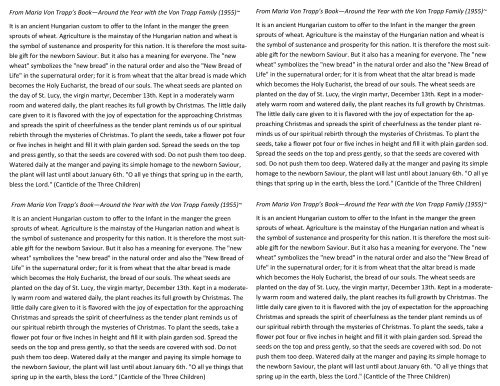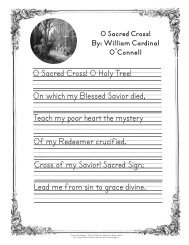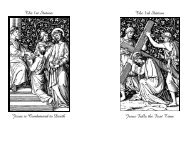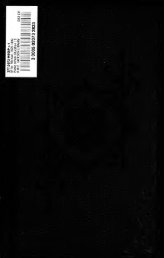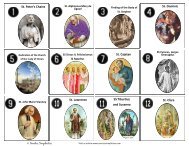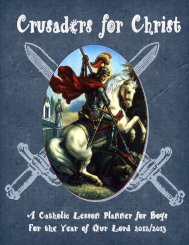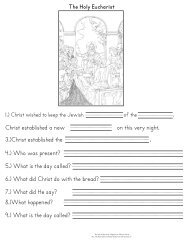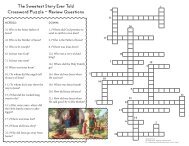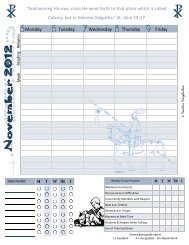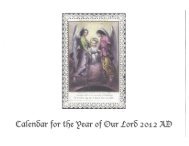Download File - Sanctus Simplicitus
Download File - Sanctus Simplicitus
Download File - Sanctus Simplicitus
- No tags were found...
You also want an ePaper? Increase the reach of your titles
YUMPU automatically turns print PDFs into web optimized ePapers that Google loves.
From Maria Von Trapp’s Book—Around the Year with the Von Trapp Family (1955)~It is an ancient Hungarian custom to offer to the Infant in the manger the greensprouts of wheat. Agriculture is the mainstay of the Hungarian nation and wheat isthe symbol of sustenance and prosperity for this nation. It is therefore the most suitablegift for the newborn Saviour. But it also has a meaning for everyone. The "newwheat" symbolizes the "new bread" in the natural order and also the "New Bread ofLife" in the supernatural order; for it is from wheat that the altar bread is made whichbecomes the Holy Eucharist, the bread of our souls. The wheat seeds are planted onthe day of St. Lucy, the virgin martyr, December 13th. Kept in a moderately warmroom and watered daily, the plant reaches its full growth by Christmas. The little dailycare given to it is flavored with the joy of expectation for the approaching Christmasand spreads the spirit of cheerfulness as the tender plant reminds us of our spiritualrebirth through the mysteries of Christmas. To plant the seeds, take a flower pot fouror five inches in height and fill it with plain garden sod. Spread the seeds on the topand press gently, so that the seeds are covered with sod. Do not push them too deep.Watered daily at the manger and paying its simple homage to the newborn Saviour,the plant will last until about January 6th. "O all ye things that spring up in the earth,bless the Lord." (Canticle of the Three Children)From Maria Von Trapp’s Book—Around the Year with the Von Trapp Family (1955)~It is an ancient Hungarian custom to offer to the Infant in the manger the greensprouts of wheat. Agriculture is the mainstay of the Hungarian nation and wheat isthe symbol of sustenance and prosperity for this nation. It is therefore the most suitablegift for the newborn Saviour. But it also has a meaning for everyone. The "newwheat" symbolizes the "new bread" in the natural order and also the "New Bread ofLife" in the supernatural order; for it is from wheat that the altar bread is madewhich becomes the Holy Eucharist, the bread of our souls. The wheat seeds areplanted on the day of St. Lucy, the virgin martyr, December 13th. Kept in a moderatelywarm room and watered daily, the plant reaches its full growth by Christmas.The little daily care given to it is flavored with the joy of expectation for the approachingChristmas and spreads the spirit of cheerfulness as the tender plant remindsus of our spiritual rebirth through the mysteries of Christmas. To plant theseeds, take a flower pot four or five inches in height and fill it with plain garden sod.Spread the seeds on the top and press gently, so that the seeds are covered withsod. Do not push them too deep. Watered daily at the manger and paying its simplehomage to the newborn Saviour, the plant will last until about January 6th. "O all yethings that spring up in the earth, bless the Lord." (Canticle of the Three Children)From Maria Von Trapp’s Book—Around the Year with the Von Trapp Family (1955)~It is an ancient Hungarian custom to offer to the Infant in the manger the greensprouts of wheat. Agriculture is the mainstay of the Hungarian nation and wheat isthe symbol of sustenance and prosperity for this nation. It is therefore the most suitablegift for the newborn Saviour. But it also has a meaning for everyone. The "newwheat" symbolizes the "new bread" in the natural order and also the "New Bread ofLife" in the supernatural order; for it is from wheat that the altar bread is madewhich becomes the Holy Eucharist, the bread of our souls. The wheat seeds areplanted on the day of St. Lucy, the virgin martyr, December 13th. Kept in a moderatelywarm room and watered daily, the plant reaches its full growth by Christmas. Thelittle daily care given to it is flavored with the joy of expectation for the approachingChristmas and spreads the spirit of cheerfulness as the tender plant reminds us ofour spiritual rebirth through the mysteries of Christmas. To plant the seeds, take aflower pot four or five inches in height and fill it with plain garden sod. Spread theseeds on the top and press gently, so that the seeds are covered with sod. Do notpush them too deep. Watered daily at the manger and paying its simple homage tothe newborn Saviour, the plant will last until about January 6th. "O all ye things thatspring up in the earth, bless the Lord." (Canticle of the Three Children)From Maria Von Trapp’s Book—Around the Year with the Von Trapp Family (1955)~It is an ancient Hungarian custom to offer to the Infant in the manger the greensprouts of wheat. Agriculture is the mainstay of the Hungarian nation and wheat isthe symbol of sustenance and prosperity for this nation. It is therefore the most suitablegift for the newborn Saviour. But it also has a meaning for everyone. The "newwheat" symbolizes the "new bread" in the natural order and also the "New Bread ofLife" in the supernatural order; for it is from wheat that the altar bread is madewhich becomes the Holy Eucharist, the bread of our souls. The wheat seeds areplanted on the day of St. Lucy, the virgin martyr, December 13th. Kept in a moderatelywarm room and watered daily, the plant reaches its full growth by Christmas. Thelittle daily care given to it is flavored with the joy of expectation for the approachingChristmas and spreads the spirit of cheerfulness as the tender plant reminds us ofour spiritual rebirth through the mysteries of Christmas. To plant the seeds, take aflower pot four or five inches in height and fill it with plain garden sod. Spread theseeds on the top and press gently, so that the seeds are covered with sod. Do notpush them too deep. Watered daily at the manger and paying its simple homage tothe newborn Saviour, the plant will last until about January 6th. "O all ye things thatspring up in the earth, bless the Lord." (Canticle of the Three Children)


